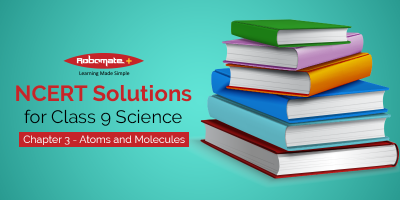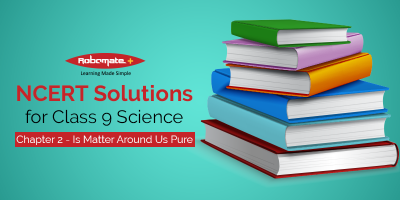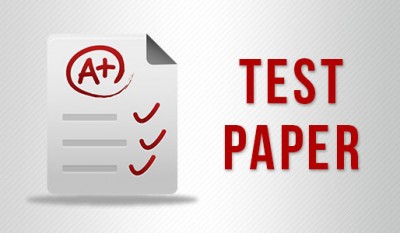State Board Commerce (XI-XII) - Test Papers
NCERT Solutions for Class 9 Science Chapter 3 – Atoms and Molecules
Atom
Atoms are the smallest particles of an element which can take reaction.
Size of an atom: Atomic radius is measured in nanometres.
Atomic radii of hydrogen atom = 1 × 10–10 m.
Molecule
It is the smallest particle of an element or compound which can exist independently.
- Molecules of an element constitute same type of atoms.
- Molecules may be mono-atomic, di-atomic or polyatomic.
- Molecules of compounds join together in definite proportions and constitute different type of atoms.
Dalton’s Atomic Theory
- Every matter is made up of very small or tiny particles called atoms.
- Atoms are not divisible and cannot be created or destroyed in a chemical reaction.
- All atoms of a given element it are same in size, “mass and chemical properties.
- Atoms of different elements are different in size, mass and chemical properties.
- Atoms combine in the ratio of small whole number to form compounds.
- The relative number and kinds of atoms are constant in a given compound. 9
Atomicity
The number of atoms constituting a Molecule is known as its atomicity.
Ions
The charged particles (atoms) are called ions, they charge or negative charge on it:
Negatively charged ions called anion (C1�).
Positively charge ion is called cation (Na+).
Valency
The combining capacity of an element is known as its valency: Valency is used to find out how atom of an element will combine with the atom of another element to form a chemical compound.
To get in-depth knowledge of atoms and molecules the students can refer to atoms and molecules class 9 notes pdf and atoms and molecules class 9 ncert solutions pdf for further clarity.
NCERT Solutions for Class 9 Science Chapter 3 – Atoms and Molecules
NCERT Solutions for Class 9 Science Chapter 2 – Is Matter Around Us Pure
Pure Substances
Pure substances may be defined as material which contains only one kind of atoms s or molecules. The measure of whether a substance is pure is known as purity.
Elements and compounds are pure substances.
- A pure substance has uniform composition and properties in all its parts, as it consists of particles of only one kind. For example, sugar and salt are pure substances.
- It has certain characteristics such as specific temperatures at which it melts and boils. For example, pure water boils at 100°C.
- The constituents which make up a pure substance cannot be separated by physical means.
Impure Substances
Mixtures are impure substances.
- A substance is said to be impure if it has particles of other substances mixed in it.
- The constituents of impure substances may be present in any ratio.
- The constituents of an impure substance retain their individual properties. For example, the properties of iron and sand do not change when they are mixed together.
- The constituents of an impure substance can be separated by physical means.
Types of Substances
Substances are basically classified into two types. They are:
- Pure Substance: Examples of pure substances include iron, aluminum, silver, and gold.
- Mixtures: Examples of mixture include the salt solution which is a ‘mixture’ of two components, salt, and water.
Compounds
Compound is a pure substance made up of two or more elements combined chemically in a definite ratio.
Characteristics:
- The properties of compound differ from those of its constituents.
- Compound has fixed melting point and boiling point.
- Compound is a homogeneous substance.
- Constituent elements can be separated by chemical process.
Mixtures
It is made up of two or more elements or compounds mixed in any ratio/proportion.
Properties:
- It may be homogeneous of heterogeneous.
- The properties of constituent substances are retained.
- No new compound is formed.
- Elements can be separated by simple physical processes.
- It does not have fixed melting and boiling point.
Solution
- It is a homogeneous mixture of two or more substances.
To get in-depth knowledge about class 9 chemistry chapter 2 notes the students can refer to is matter around us pure class 9 notes pdf.
NCERT Solutions for Class 9 Science Chapter 2 – Is Matter Around Us Pure
NTSE Stage 1 SAT Sample Papers
NTSE Stage 1 SAT Sample Papers
For Answers Please Click here
NTSE Stage 1 MAT Sample Papers
NTSE Stage 1 MAT Sample Papers
For Answers Please Click here
KVPY Sample Paper
For Answers Please Click here
How to Integrate Technology in Education : Mr Eugene D’Monte, Principal, St. Peter’s School
Mr Eugene D’Monte, Principal, St. Peter’s School joins R+ Talks with his views about integrating technology into the education system. Mr D’Monte is also Treasurer and Honorary Secretary of the Association of the Heads of Anglo Indian Schools (India).
Mr D’Monte answers questions ranging from sensitizing teachers and parents to adapt technology for learning and schools’ role in harmonizing technology in its day to day activities









